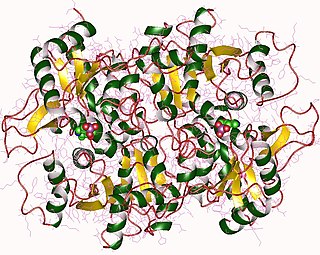
Riboflavin, also known as vitamin B2, is a vitamin found in food and sold as a dietary supplement. It is essential to the formation of two major coenzymes, flavin mononucleotide and flavin adenine dinucleotide. These coenzymes are involved in energy metabolism, cellular respiration, and antibody production, as well as normal growth and development. The coenzymes are also required for the metabolism of niacin, vitamin B6, and folate. Riboflavin is prescribed to treat corneal thinning, and taken orally, may reduce the incidence of migraine headaches in adults.

Vitamin B6 is one of the B vitamins, and thus an essential nutrient. The term refers to a group of six chemically similar compounds, i.e., "vitamers", which can be interconverted in biological systems. Its active form, pyridoxal 5′-phosphate, serves as a coenzyme in more than 140 enzyme reactions in amino acid, glucose, and lipid metabolism.
B vitamins are a class of water-soluble vitamins that play important roles in cell metabolism and synthesis of red blood cells. They are a chemically diverse class of compounds, but are associated in diet, often occurring together in the same foods. Dietary supplements containing all eight are referred to as a vitamin B complex. Individual B vitamins are referred to by B-number or by chemical name, such as B1 for thiamine, B2 for riboflavin, and B3 for niacin, while some are more commonly recognized by name than by number, such as pantothenic acid (B5), biotin (B7), and folate (B9).

Homocystinuria or HCU is an inherited disorder of the metabolism of the amino acid methionine due to a deficiency of cystathionine beta synthase or methionine synthase. It is an inherited autosomal recessive trait, which means a child needs to inherit a copy of the defective gene from both parents to be affected. Symptoms of homocystinuria can also be caused by a deficiency of vitamins B6, B12, or folate.

Pyridoxal phosphate (PLP, pyridoxal 5'-phosphate, P5P), the active form of vitamin B6, is a coenzyme in a variety of enzymatic reactions. The International Union of Biochemistry and Molecular Biology has catalogued more than 140 PLP-dependent activities, corresponding to ~4% of all classified activities. The versatility of PLP arises from its ability to covalently bind the substrate, and then to act as an electrophilic catalyst, thereby stabilizing different types of carbanionic reaction intermediates.

Pyridoxine 5′-phosphate oxidase is an enzyme, encoded by the PNPO gene, that catalyzes several reactions in the vitamin B6 metabolism pathway. Pyridoxine 5′-phosphate oxidase catalyzes the final, rate-limiting step in vitamin B6 metabolism, the biosynthesis of pyridoxal 5′-phosphate, the biologically active form of vitamin B6 which acts as an essential cofactor. Pyridoxine 5′-phosphate oxidase is a member of the enzyme class oxidases, or more specifically, oxidoreductases. These enzymes catalyze a simultaneous oxidation-reduction reaction. The substrate oxidase enzymes is hydroxlyated by one oxygen atom of molecular oxygen. Concurrently, the other oxygen atom is reduced to water. Even though molecular oxygen is the electron acceptor in these enzymes' reactions, they are unique because oxygen does not appear in the oxidized product.

Cystathioninuria, also called cystathionase deficiency, is an autosomal recessive metabolic disorder. It is characterized by an abnormal accumulation of plasma cystathionine leading to excess cystathionine in the urine. Hereditary cystathioninuria is associated with the reduced activity of the enzyme cystathionine gamma-lyase. It is considered a biochemical anomaly. This is because it associated with a wide range of diseases and its inconsistency.

Hyperprolinemia is a condition which occurs when the amino acid proline is not broken down properly by the enzymes proline oxidase or pyrroline-5-carboxylate dehydrogenase, causing a buildup of proline in the body.
In enzymology, a 4-hydroxythreonine-4-phosphate dehydrogenase (EC 1.1.1.262) is an enzyme that catalyzes the chemical reaction
In enzymology, a pyridoxal 4-dehydrogenase (EC 1.1.1.107) is an enzyme that catalyzes the chemical reaction
In enzymology, a pyridoxine 4-oxidase (EC 1.1.3.12) is an enzyme that catalyzes the chemical reaction
The enzyme 3-hydroxy-2-methylpyridine-4,5-dicarboxylate 4-decarboxylase (EC 4.1.1.51) catalyzes the chemical reaction

The enzyme threonine synthase (EC 4.2.3.1) catalyzes the chemical reaction
In enzymology, a 2-(acetamidomethylene)succinate hydrolase (EC 3.5.1.29) is an enzyme that catalyzes the chemical reaction
In enzymology, a 2-(hydroxymethyl)-3-(acetamidomethylene)succinate hydrolase (EC 3.5.1.66) is an enzyme that catalyzes the chemical reaction

In enzymology, a pyridoxine 5'-phosphate synthase (EC 2.6.99.2) is an enzyme that catalyzes the chemical reaction

4-Deoxypyridoxine is a vitamin B6 antagonist. It may be toxic to developing embryos since it can have negative effects on collagen and elastin during development. The presence of this compound can produce vitamin B6 deficiency, which suppresses the immune system. 4-Deoxypyridoxine lowers vitamin B6 concentration by competitively inhibiting some of the enzymes necessary for the regeneration of vitamin B6.The related immunosuppression can be beneficial in animal models of Trichinella spiralis infections. 4-Deoxypyridoxine has also been described as an inhibitor of sphingosine-1-phosphate lyase. The inhibition of sphingosine-1-phosphate lyase by 4-Deoxypyridoxine has been shown to prevent cell death of ex-vivo animal pancreatic islets. The use of 4-Deoxypyridoxine to prevent stress-induced apoptosis is suggest that the compound, as well as other inhibitors of sphingosine-1-phosphate lyase, could be used to increase the viability of donor pancreatic tissue in the treatment of diabetes.
Tiger is an energy drink, produced by Polish company Maspex.
Alexander Yevseyevich Braunstein (1902–1986) was a Soviet biochemist. He is best known for his co-discovery, along with Maria Kritzman, of enzymatic transamination and its dependence on vitamin B6. Braunstein and American scientist Esmond Emerson Snell have been cited as the "fathers of vitamin B6".
Megavitamin-B6 syndrome is a collection of symptoms that can result from chronic supplementation, or acute overdose, of vitamin B6. While it is also known as hypervitaminosis B6, vitamin B6 toxicity and vitamin B6 excess, megavitamin-b6 syndrome is the name used in the ICD-10.









